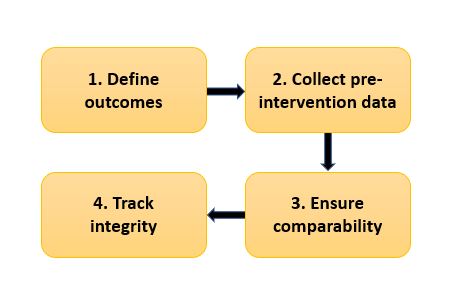Impact evaluations are often described as the gold standard of evidence-based decision-making. Governments, donors, and organizations rely on them to understand what works, what fails, and why. These evaluations inform billion-dollar policies and shape interventions that affect millions of lives.
Yet, one of the most common—and costly—mistakes is attempting to measure impact without establishing a proper baseline.
At first glance, skipping a baseline may appear to save time and resources. However, the reality is stark: an evaluation without a baseline is like building a house without a foundation. The structure may appear complete, but under scrutiny, it crumbles.
Why Baselines Matter
1. Establishing the Counterfactual
Impact evaluation depends on comparing outcomes with and without an intervention. The baseline provides the “before picture”, which is essential for constructing the counterfactual—what would have happened otherwise.
Without it, claims of success or failure become speculation. For example, a new agricultural program may show higher yields, but without baseline data, it is impossible to know if those yields were already improving due to favorable weather.
2. Separating Impact from Noise
External factors—such as economic shocks, inflation, or seasonal variations—can mask or mimic program results. Baselines help evaluators separate program impact from background noise.
A 2019 UNDP study showed that interventions measured without baselines often misattributed outcomes to programs that were actually driven by unrelated policy shifts. This undermines credibility and wastes resources.
3. Turning Description into Causation
Evaluations that measure only “after” conditions are descriptive, not causal. They can tell us what exists, but not why it exists.
For example, post-only surveys might report that employment increased after a skills program. But without baseline data, we cannot prove whether the program caused the increase, or whether the job market was already improving.
A baseline ensures valid before-and-after comparisons and strengthens causal claims—critical for policy and funding decisions.
4. Protecting Policy Integrity
Policies built on weak evaluations often lead to misguided recommendations, wasted budgets, and disillusioned stakeholders. Donors increasingly require rigorous, baseline-based studies before approving funding.
According to OECD DAC (2022), evaluations without baselines are rarely considered credible evidence and often fail peer or donor reviews. This creates reputational risks for organizations and reduces trust in evaluation systems.
Risks of Skipping Baselines
- False Attribution: Claiming program impact when changes stem from unrelated factors.
- Weak Credibility: Evaluations collapse under donor or policy scrutiny.
- Lost Learning: Without a clear starting point, organizations cannot replicate or scale successful interventions.
- Policy Misguidance: Poor evidence may shape harmful or ineffective policies.
Best Practices for Building Strong Baselines
At Research & Report Consulting, we emphasize that baselines are not just about collecting “before” data—they must be strategic, reliable, and comparable.
- Align Indicators with Outcomes
Ensure baseline measures match final outcome indicators for consistency. - Use Mixed Methods
Combine surveys, interviews, and secondary data to strengthen context and validity. - Design for Counterfactuals
Where possible, include control or comparison groups to establish causality. - Maintain Data Integrity
Use standardized tools, minimize recall bias, and ensure representative samples.
Steps for Strong Baselines

Figure: Steps for Strong Baselines
Source: OECD DAC Guidelines, 2022
Final Thought
Impact evaluations without baselines are descriptive at best and misleading at worst. If the goal is to influence policy, attract funding, or scale interventions, skipping the baseline is not an option.
A strong baseline builds the foundation for credible, actionable, and policy-relevant evidence. Just as a house depends on a solid base, so too does evidence-based decision-making.
At Research & Report Consulting, we help organizations design evaluations that stand on firm methodological ground. Because credible evidence—like any strong structure—starts with a strong base.
References
World Bank (2020). Impact Evaluation Guidance.

